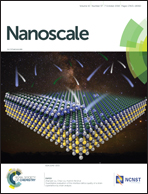Effect of liquid droplet surface tension on impact dynamics over hierarchical nanostructure surfaces†
Abstract
Analyzing impact dynamics is important for practical applications of superhydrophobic surfaces, because these nonwetting surfaces frequently encounter impacting liquid droplets in real environments. Thus, various studies have been conducted to investigate impact dynamics by examining the correlation between the behaviors of impacting liquid droplets and several determining parameters, such as impacting velocity, surface structure and surface energy. The impacting behaviors of pure water droplets were the main focus in most previous studies; the effect of surface tension, another critical parameter, on impact dynamics has rarely been investigated. In the current work, we have newly studied the effects of liquid surface tension on impact dynamics using an ethanol–water solution as a model liquid system. We systematically varied the liquid's surface tension between 72 and 32 mN m−1 by changing the ethanol concentration from 0 to 20 wt%. This range of composition drastically changed the surface tension while it did not significantly affect other physical properties, such as density and viscosity. For an impact dynamics study, two surfaces, namely ZnO nanowires (NWs) and ZnO/Si hierarchical (HIE) structures, were prepared. As the surface tension decreased, the static water contact angle (CA) decreased on both surfaces. Under dynamic conditions, our analysis using a high-speed camera and a quartz crystal microbalance (QCM) showed that lowering the surface tension causes the transition from the anti-wetting to wetting state. The transition We numbers were obtained on both surfaces for various surface tensions of liquids. Under the same dropping conditions of liquids, the ZnO/Si HIE surface shows higher transition We numbers than the ZnO NW surface, which is due to the higher fraction of air pockets in the hierarchical structure, originating from dual dimensional structures. To understand the mechanism of dynamic transition, we developed a model for ZnO/Si HIE structures based on three determining pressures: anti-wetting, wetting, and effective water hammer pressures. The modeling results explain the experimental observations. The results of our model system are highly useful for understanding the impact dynamic behaviors of various liquids on non-wetting surfaces.



 Please wait while we load your content...
Please wait while we load your content...